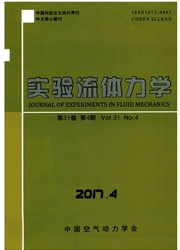

 中文摘要:
中文摘要:
采用CFD数值模拟技术与风洞试验相结合的手段模拟了复杂建筑物群对周围流动与污染物扩散的影响。CFD技术采用k-ε(RNG)湍流模型模拟了建筑物群对流动与扩散的影响,风洞试验通过采用多种探测手段,分析建筑物群周围的流动和弥散,并将统计学方法应用于风洞试验结果,验证了CFD数值模拟结果的合理性。研究结果表明,CFD技术能较好地模拟建筑物群对污染物弥散的影响,并与风洞试验吻合,有、无建筑物B的情况下,吻合因子FAC2与FAC5均大于50%,归一化均方误差(NMSE)均小于4,部分偏差(|FB|)均小于0.3;建筑物对污染物弥散的影响非常复杂,建筑物尾流对污染物浓度分布影响较为显著,建筑物后方空腔区污染物的数值模拟结果略高于风洞试验结果。综合分析表明,风洞试验与数值模拟相结合的方法是研究这类微小尺度湍流扩散问题的有效手段。
 英文摘要:
英文摘要:
The flow and dispersion of gases emitted from many small air vents on the top of buildings located near complex buildings were simulated by the computational fluid dynamics (CFD) code STAR-CD using the/re (RNG) turbulent closure approximation. This study evalua- ted the performance of the h-ε (RNG) turbulent model applied to pollutant dispersion in an actual urban environment. The focus of the study was on lution CFI) simulations were performed for neutral near field flow and dispersion. The high reso- atmospheric conditions and were validated by detailed wind-tunnel experiments. The result of research showed CFD gives a preferable image compared to the wind tunnel experiment in terms of accuracy of predicted concentrations. A fac- tor of 2 or 5 was higher than 50%, the normalized mean square error (NMSE) was lower than 4, and the absolute of fractional bias (FB) was lower than 0.3, no matter B building existed or not. The effects of buildings on pollutant dispersion were very complex; however, numerical simula- tion's result of the pollutantst dispersion was slightly higher than that from wind tunnel experi- ments in the rear cavity zones. As a whole, it was showed that this is a powerful tool for investi- gating this kind of turbulent diffusion with micro-scale atmospheric dispersion by wind tunnel ex- periment and CFD numerical simulation.
 同期刊论文项目
同期刊论文项目
 同项目期刊论文
同项目期刊论文
 期刊信息
期刊信息
